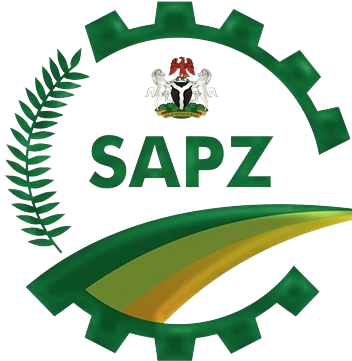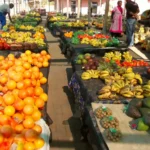- Background to the Program
The Federal Government of Nigeria (FGN) has secured a facility from the African Development Bank (AfDB), International Fund for Agricultural Development (IFAD), and Islamic Development Bank (IsDB) to implement a five-year AfDB/IFAD/IsDB-Assisted Special Agro-Industrial Processing Zone (SAPZ) Program in partnership with the State Governments and Private Investors in seven (7) participating states (Imo, Kaduna, Cross River, Kano, Kwara, Oyo, and Ogun) and Federal Capital Territory (FCT) in the first phase.
The SAPZ Program goal is to increase household incomes, foster job creation in rural agricultural communities, especially for youth and women, and enhance food and nutritional security in Nigeria. The development objective is to support inclusive and sustainable agro-industrial development. The specific objective of the SAPZ program is to increase the competitiveness and business environment of the Nigerian agriculture sector, through the provision of hard and soft infrastructure that would allow the crowding-in of private investment into the sector, both at the upstream and downstream axes of the value chains. At completion, the IFAD’s target is to reach 100,000 direct beneficiaries (500,000 indirect beneficiaries) in two (2) states (Kano and Ogun) through the SAPZ Program; such that 50% are women and 40% are youth entrepreneurs. The above figure of target reach includes 5,000 internally displaced persons (IDPs) and 100 people living with disability or households with a member living with disability.
The Program’s target groups include enterprise groups (smallholder producers, processors and traders) across various priority crops/commodities identified in the program states. Similarly, value chain services providers (agro-input dealers, extension advisory services providers, etc.), off-takers MSMEs, financial service providers, and so on, would be reached by the SAPZ Program.
Pursuant to the above goals and objectives, the SAPZ has been designed to be implemented through four distinct components, namely:
i. Component 1- Support the Development of Enabling Infrastructure and Management of Agro-Industrial Zones in Nigeria;
ii. Component 2- Agricultural Productivity and Production
iii. Component 3- Policy and Institutional Capacity Development Support
iv. Component 4- Project Coordination and Management
As part of the programme implementation activities at start, the SAPZ intends to apply part of the IFAD fund to the development and deployment of a robust monitoring and evaluation software that would provide the programme with an effective and efficient management information system (MIS) with a visual dashboard showcasing the snapshot of key performance indicators of the programme. This is necessary to track the progress of achievement of project activities and interventions over time and space as evident in the annual workplan and budget, track beneficiaries’ locations as well as populate a general database for the programme.
- Background of the Assignment
A vital component of the M&E process is setting clear and measurable objectives that guide the collection and analysis of data. The proposed system should be capable of accommodating continuous growth as far as new technologies are concerned. The system should be purpose-built for the projects, relevant stakeholders and beneficiaries’ use and support. An efficient M&E system will:
i. Facilitate continuous data input, analysis, reporting, and storage.
ii. Facilitate project management, accountability, and learning to improve performance
iii. Provide reporting functionalities for all implementing and executing actors collaboratively.
iv. Define administrative rights and data exchange levels.
v. Integrate various project components and ensure effective measurement of inputs, outputs, and outcomes.
vi. Support expansion and integration of new projects.
vii. Include knowledge management interfaces and visualization dashboards
This ToR guides the development of the integrated M&E and Knowledge Management system for project activities, including digital innovations, technologies, and tools in project areas in Nigeria. The selected vendor will play a critical role in ensuring effectiveness and sustainability, as well as monitoring and measuring the impact of project progress. Thus, ultimately, the system enhances the provision of evidence and reporting of Nigeria’s agricultural productivity and farmer livelihoods. The ToR outlines the scope of work and expected deliverables for the M&E system. The system should be able to integrate with other project activities related to bundled services, e-vouchers, and farmer registries. This RFP aims to ensure the development, installation, and commissioning of a comprehensive, integrated, and effective M&E system, as well as developing a detailed Monitoring and Evaluation Manual. A standout feature of the system is its ability to provide automated reports on project Key Performance Indicators (KPIs) and recommend progress and broader policy options, enabling strategic decision-making. - Objectives of the Consultancy
The main objective of this consultancy is to provide a time-tested, robust, flexible and user-friendly monitoring and evaluation (M&E) software, monitoring and evaluation manual, and performance monitoring plan (PMP) to support the SAPZ Programme in building a database of its activities for ease of tracking of performance achievements and results along the line of key performance indicators. This integrated MIS software is part of the efforts at digitalizing the entire SAPZ ecosystem in the five participating states of Cross-River, Imo, Kaduna, Ogun, and Oyo and the National Coordination Office.
The Specific Objectives of the consultancy are to:
a. Review similar M&E software such as the ones deployed by other donor-funded programmes and projects in Nigeria to adapt relevant features.
b. Review the SAPZ Chart of Accounts developed in Flexible Accounting Software with the intention of adapting the codes for workplan and budget preparation, thereby linking the AWPB with disbursements;
c. Review similar M&E software, manual and performance monitoring plan (PMP) of existing donor-assisted programmes/projects like the ATASP-1, VCDP, LIFE-ND, and others.
d. Review the SAPZ Programme documents to gain better insight of the design, key performance indicators, target beneficiaries, stakeholders and coverage with a view to creating a better content provision for the software.
e. Develop a user-friendly, gender-responsive flexible but robust and centralized integrated M&E system across multiple projects to ensure cohesive tracking and evaluation of the SAPZ Programme; with potential for periodic expansion (upgrade), and capable of consolidating data on all value chain actors and MSMEs, and generating workplans and budgets, reports.
f. Create a monitoring and visualization dashboard for real-time progress tracking and reporting.
g. Monitor user interactions, identify bugs, gather feedback, and assess overall user satisfaction with project activities and digital tools used to execute the projects.
h. Build a system that maps and tracks indicators relevant to the deployment and impact of the project’s activities. Once integrated, the M&E system will serve as a tool for monitoring project result (indicators) and a means of enhancing the technical capacity and expertise of relevant staff, making it an integral part of all project activities
i. To provide technical advisory services in integrating all the M&E systems across all the projects, mainly focusing on system specifications and requirements.
j. Foster the development of an integrated M&E system for all the projects and build staff capacity, equipping them with the necessary skills to utilize the M&E system effectively.
k. Ensure the scalable M&E system is adaptable to all existing projects, new project activities, and tracking requirements; while also having knowledge management features to support organizational learning and decision making. (Monic feature: this open-source M&E system that has components for Monitoring, theories of change, logical frameworks, and knowledge management). It allows users to store documents in folders, share them with groups and link them to various items, facilitating knowledge sharing and collaboration.
l. Systemize and streamline the integration of the M&E system in accordance with AfDB-funded NAGS-AP database, IFAD’s ICT4D strategy, Nigeria country ICT strategies, and other ongoing programs and project result frameworks.
m. Prepare a comprehensive M&E manual and Performance Monitoring Plan (PMP) for the SAPZ Programme.
n. Design and develop a database of SAPZ actors (smallholder farmers, agro-processors, agro-dealers, off-taker MSMEs, and other value chain actors for ease of data management, reporting, budgeting, planning, performance monitoring (tracking) and real-time visualization (dashboard) of the key performance indicators.
o. Develop a customized offline and online mobile data collection application for the M&E software to enable seamless data collection and transmission/update to the database.
Kindly download the attached for more details please.






Recent Comments